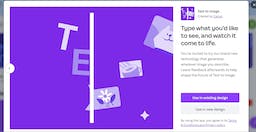User's Area

Canva Text to Image
AI-generated images from verbal descriptions.
What is Canva Text to Image?
Brand-new Image Generation Technology
A revolutionary new technology has been developed that has the ability to produce images based solely on verbal descriptions. The innovation employs advanced algorithms and artificial intelligence to understand and interpret descriptions of images provided by users and then generates corresponding visual representations. This groundbreaking technology has the potential to significantly impact various industries including art, design, communication, and accessibility.
The system operates by utilizing machine learning techniques to analyze the nuances of natural language and translate them into vivid visual content. Users can simply describe the image they have in mind, and the technology is able to recognize and process the information to create an accurate visual depiction. This streamlined process eliminates the need for complex design software or artistic skills, making image generation accessible to a broader audience.
The implications of this technology extend to diverse fields, such as graphic design, where professionals can leverage the system to quickly and effortlessly produce visual concepts based on verbal instructions. Additionally, this newfound capability opens up opportunities for visually impaired individuals to have access to visual content by describing the images they wish to "see." Furthermore, the technology has the potential to democratize the creation of visual content, empowering individuals without traditional artistic skills to express their ideas through imagery.
Applications in Various Industries
The potential applications of this image generation technology are vast and far-reaching. In the field of advertising and marketing, it could streamline the process of creating visual campaigns by enabling marketers to articulate their vision through verbal descriptions rather than relying on graphic designers to interpret their ideas. Moreover, the technology could also revolutionize the creation of visual content for social media platforms, allowing users to generate captivating images directly from their descriptions.
In the realm of education, this technology could be utilized to enhance learning materials by providing an innovative way to illustrate concepts and ideas. Students and educators could benefit from the ability to generate visual aids based on textual descriptions, thereby facilitating a deeper and more accessible understanding of complex topics. This would also be instrumental in making educational resources more inclusive for individuals with diverse learning needs.
Impact on Art and Creativity
From an artistic standpoint, this technology could serve as a powerful tool for both established and aspiring artists. It offers a novel approach to visual expression, allowing individuals to bring their creative visions to life through verbal descriptions. This could potentially revolutionize the creative process, encouraging exploration and experimentation in the art world.
Moreover, the technology could be integrated into virtual reality and augmented reality applications, enabling users to translate their verbal descriptions into immersive visual experiences. This integration has the potential to redefine the way people interact with visual content and expand the possibilities for artistic expression in digital environments.
In conclusion, the development of this image generation technology marks a significant milestone in the realm of visual communication and creativity. Its potential to simplify and democratize the creation of visual content, its diverse applications across various industries, and its impact on accessibility and inclusion make it a truly transformative innovation with wide-ranging implications for society.
Canva Text to Image Details
- Links
- Visit Website
- Plans and Pricing
- free
- Tags
- #canva ai text to image # ai generated images canva # canva text on image # canva image generator ai #canva word to image # canva text to image #text to image canva # canva art generator # canva text to image # canva ai text to image # ai text to image canva # canva ai art generator # ai generated images canva # canva image ai # canva image generator # canva text on image # canva image generator ai # canva ai art # canva text to image ai